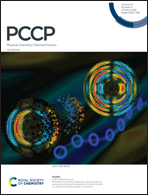High energy state interactions, energetics and multiphoto-fragmentation processes of HI†
Abstract
Mass resolved multiphoton ionization data for two-photon resonant excitations (REMPI) in the 69 000–79 000 cm−1 region were recorded for HI. REMPI spectra of fragment and molecular ions were derived from the data and analysed to obtain information relevant to the state interactions, energetics and photofragmentation processes of intermediate Rydberg and ion-pair states (HI**). Spectral perturbations observed as line shifts and intensity anomalies acted complementarily to demonstrate the effects of the state interactions. The interaction strength and character mixing of Rydberg states and Rydberg and ion-pair states of different interaction types and the states energetics were quantified by deperturbation analysis for the high energy region of 75 000–79 000 cm−1, which is dense in states. Energetics of new, not previously observed, Rydberg states, detected in the lower energy excitation region of 69 000–75 000 cm−1 was characterized by simulation calculations. Ion intensity borrowing effects, found in the spectra of interacting states, are evidence of alterations in two-photon transition probabilities due to state mixing. Based on variations in relative spectral line intensities the major photofragmentation processes involved are proposed. These involve one-photon excitation of the intermediate states (HI**) to form repulsive superexcited states (HI#) followed by autoionization, dissociation, photodissociation and photoionization processes to form ions. The importance of state interactions in multiphoton-fragmentation processes is evident from the work.



 Please wait while we load your content...
Please wait while we load your content...